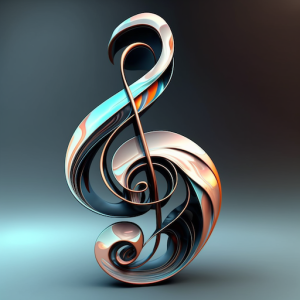In the vast and wondrous landscape of humanity, music is a powerful form of expression that reflects the richness of our collective experience. It is a tapestry of lyrics, symbolism, and psychology that weaves together to create something truly beautiful.

The Power of Lyrics: Connecting Through Emotion
The lyrical aspect of art, like a mellifluous nightingale, beckons us to pause and listen, to witness the world around us through the evocative power of language.
Lyrics have the unique ability to capture the essence of our emotions, both the exuberant and the melancholic, with a depth and resonance that transcends the limitations of spoken words.
For example, in Billie Eilish’s song “When The Party’s Over,” she sings:
“Don’t you know I’m no good for you? I’ve learned to lose, you can’t afford to.”
These lyrics invite the listener to connect with the feeling of knowing one is not good for someone else, but at the same time, not wanting to let go. The subtle nuances of language allow for a profound emotional connection, transcending the barriers of individual experience.

The Intricacy of Symbolism: Guiding the Journey
Symbolism, on the other hand, is the beacon that illuminates the hidden corners of our consciousness, guiding our journey through the labyrinth of life. It is the embodiment of our aspirations and our fears, the vessel that carries us through the tumultuous seas of existence.
Take, for instance, Bob Dylan’s timeless song “Blowin’ in the Wind.” The lyrics convey a sense of deep questioning and reflection, as seen in these lines:
“How many roads must a man walk down Before you call him a man? How many seas must a white dove sail Before she sleeps in the sand?”
These questions, like the wind itself, remain elusive and intangible, symbolizing the eternal quest for truth and understanding in a complex world.

The Psychology of Art: Unlocking the Doors of the Mind
The psychology of art, the final thread in our melodic tapestry, serves as a key that unlocks the door to our innermost sanctuaries, revealing the intricate workings of our minds and hearts. Art, in all its resplendent forms, possesses the power to heal and transform, to unite and inspire.
For example, Kendrick Lamar’s “Alright” is not only an artistic masterpiece but also a powerful tool for social change. The lyrics and visuals evoke themes of resilience, hope, and the fight against injustice, tapping into the collective consciousness and inspiring a movement.
As we traverse the diverse landscape of human expression, we discover that the interplay of lyrics, symbolism, and psychology breathes life into the exquisite tapestry of art. Through the rich hues of language and the intricate patterns of symbols, we find ourselves connected to the vast expanse of human experience.
So, let us embrace the profound beauty of our emotions, the bittersweet symphony of our existence, and weave our stories into the magnificent tapestry of life.
For it is in the gentle embrace of art that we find solace, healing, and the strength to soar to new heights.
In the immortal words of Paul Cézanne, “A work of art which did not begin in emotion is not art.”
Let us, therefore, revel in the emotional depths of our favorite songs, celebrate the symbolism that connects us, and appreciate the transformative power of the art that surrounds us every day.
If you enjoyed this exploration into the world of lyrics, symbolism, and the psychology of art, leave a comment and share it with fellow art enthusiasts!













